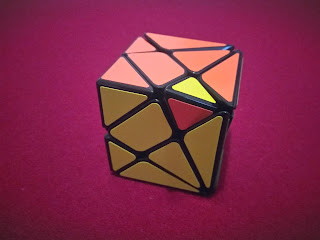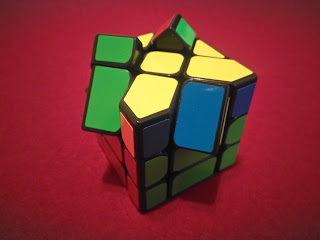Axis Cube
The Fisher and Windmill cubes don't offer a significantly higher challenge to a person proficient in solving a standard 3x3x3. The only additional aspect is controlling the orientations of the pieces that behave like centres.
The Axis Cube, also known as the Axel Cube, is a significant step up in difficulty. It is still based in the 3x3x3 mechanism but the shape modification makes the puzzle confusing, especially when picking the puzzle up for the first time. Familiarity should be gained with the workings of the puzzle; that is knowing which pieces behave like edges, corners and centres, and understanding what corresponds to a face on a normal cube. Once this hurdle is crossed, it should be easier to solve.
The way the pieces are cut means that a equivalent to a face, as we understand it from a regular cube, is not one colour and not a side of the cube. The picture below shows a "face" rotated by 180°.
Solution
The puzzle shape shifts into a chaotic jumble when scrambled. It can be confusing when figuring out which pieces behave like corners, edges and centres, and how they go together during a solve.
Step 1: Cross
Intuitive step but care needs to be taken to ensure that the centres on the E-layer are orientated correctly as the edges of the cross are put into place.
Step 2: First Two Layers (F2L)
Normal F2L and block building techniques work here as one might expect. Recognition will be an issue at first until familiarity is built up with the shaped pieces.
Step 3: Edges Last Layer
At this point, I see which is easier to solve first, edges or corners. If there is no advantage either way I go for corners. During the solve when I was photographing for it this post, I decided to go with edges, because that was easier.
Step 4: Solve the Corners
Next solve the corners.
Step 5: Orientate Last Layer Centre
The way I solve this puzzle, sometimes leaves the final centre rotated by 180°. So there might be one final step to finish off the solve.
























